

09/27/2021

© 2021 Motoko Kotani
A research team led by AIMR has developed a mathematical model called standard realization with repulsive interaction (SRRI) that uses the geometric information of graphene to simulate its defect-induced curvatures and properties1. Experimental comparisons with the simulated properties suggest the possible use of SRRI as complementary pre-screening tool for both density functional theory (DFT) and experimental measurements.
Scientists are still trying to understand how geometric changes in the graphene honeycomb structure can produce exotic properties.
For example, the introduction of topological defects by chemical treatments of graphene is known to both alter graphene geometry and enhance graphene catalytic properties. However, how these two observations are related to each other remains unclear.
Here, the team develops SRRI—a mathematical model that takes into account the attractive and repulsive interactions between graphene defects and their carbon-atom neighbors—to both simplify the model of interest and predict the curvatures and catalytic properties induced by graphene topological defects.
“Our approach refines an existing mathematical model2 to describe the geometric changes in systems such as graphene and investigate their properties,” says Yoshikazu Ito from the University of Tsukuba. “The resulting SRRI gives insight into the link between the geometry of the material and its properties.”
Direct comparisons indicate that while SRRI predicts graphene defect-induced properties in qualitative agreement with DFT, it does so a billion times faster.
To demonstrate the significance of these results, the team synthesizes graphene samples with similar defects and uses scanning electrochemical cell microscopy to find a link between curvature and catalytic properties similar to those predicted by SRRI.
“Our results show a fast mathematical modeling method that not only can pre-screen model systems for in-depth DFT studies, but also could be used to guide experimental measurements in real time,” says Motoko Kotani from AIMR.
Future projects will use SRRI to investigate the structure-property links of other carbon networks such as the Mackay crystal.
(Author: Patrick Han)
This research highlight has been approved by the authors of the original article and all information and data contained within has been provided by said authors.